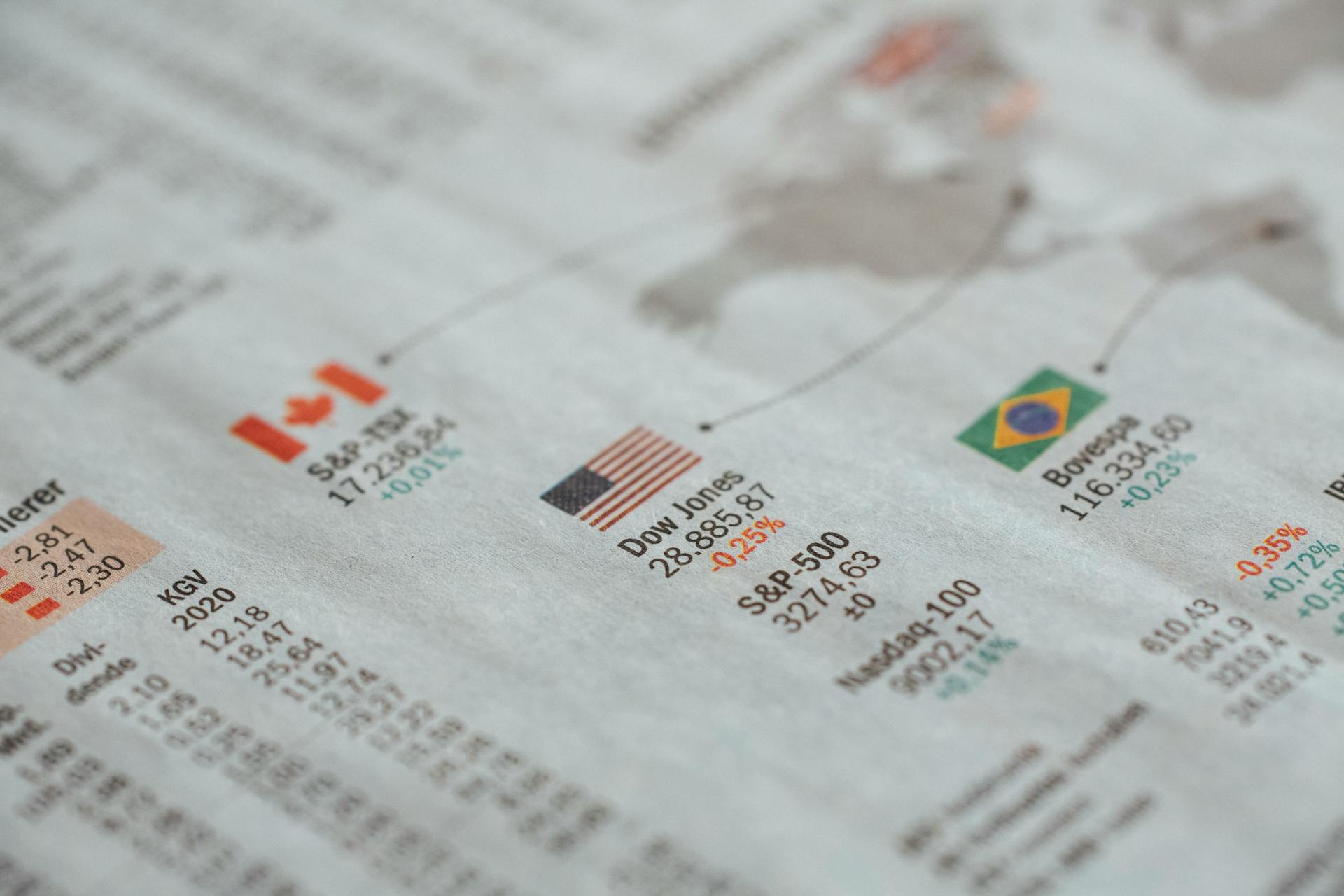
A convertible loan is a type of financing that offers investors a chance to convert their investment into equity in the company at a later date.
This type of loan is typically used by startups and small businesses that need funding but don't want to give up equity immediately. Convertible loans can be a good option for companies that are still in the early stages of development.
A key feature of convertible loans is that they can be converted into equity at a later date, usually when the company reaches a certain milestone or achieves a specific valuation. This allows investors to benefit from the company's growth without having to negotiate a new deal.
The conversion price is usually tied to the company's valuation at the time of conversion, and can be a fixed price or a formula-based price.
What is a Convertible Loan
A convertible loan is a type of financing that offers flexibility to both the borrower and the lender. It pays fixed-income interest payments, but can also be converted into a predetermined number of common stock shares.
The conversion from the loan to stock happens at specific times during the loan's life and is usually at the discretion of the borrower. This means the borrower can choose when to convert the loan into stock, if they want to.
A convertible loan offers investors a type of hybrid security that has features of a loan, such as interest payments, while also having the option to own the underlying stock. This makes it an attractive option for startups or small businesses looking for funding.
Here are the key features of a convertible loan:
- Pays fixed-income interest payments
- Can be converted into a predetermined number of common stock shares
- Conversion is usually at the discretion of the borrower
- Has features of a loan, such as interest payments, and a hybrid security that offers the option to own the underlying stock
Features and Varieties
Convertible loans offer flexible terms that can be negotiated to meet the needs of both the investor and the startup founder. This can include features like a discount, which rewards early investors for taking larger risks, and a valuation cap, which sets the maximum value of a company when a Series A round closes.
A vanilla convertible bond provides the investor with the choice to hold the bond until maturity or convert it to stock, while mandatory convertible bonds are required to be converted by the investor at a particular conversion ratio and price level.
Expand your knowledge: Private Investor Loans
Here are some key features of convertible loans:
- Conversion Option: allows the investor to convert the loan into equity shares
- Interest Payments: regular interest payments are made to the investor
- Maturity Date: a fixed date when the principal amount of the loan is due to be repaid
- Conversion Ratio: determines the number of shares that the investor will receive upon conversion
- Conversion Price: the price at which the convertible loan can be converted into equity shares
- Call and Put Options: some convertible loans come with additional flexibility for both the investor and the issuer
Types of
Convertible bonds are a versatile investment option with various types. There is no formal classification of convertible bonds in the financial markets.
Underwriters often refer to the following types, although a formal classification is lacking.
For more insights, see: Types of Bank Loans
Vanilla
Vanilla convertible bonds are the most common type of convertible bond. They offer investors the right to convert their bonds to a certain number of shares at a predetermined conversion price and rate at the maturity date.
Investors can hold the bond until maturity and get paid the face value, or convert it to stock if the stock price increases significantly. This flexibility is a key feature of vanilla convertible bonds.
The conversion ratio is fixed at the time the bond is issued and is usually expressed as the number of shares per bond. For example, a conversion ratio of 20:1 means that one bond can be converted into 20 shares of the company's stock.
Expand your knowledge: Convertible Bond

Here are the key features of vanilla convertible bonds:
Vanilla convertible bonds are a popular choice for investors because they offer flexibility and potential for upside. By understanding the key features of vanilla convertible bonds, investors can make informed decisions about their investment strategy.
How it Works
A convertible loan is a type of financing that allows investors to lend money to a startup in exchange for a promissory note, which outlines the terms of the investment.
The note typically includes details such as the principal amount, interest rate, maturity date, conversion terms, and other relevant provisions. This note is usually due within 2-5 years.
Here's how it works in a nutshell:
- An investor lends money to a startup in exchange for a convertible note.
- The investor has the option to convert the debt into equity shares in the company before the note comes due.
- If the investor converts the debt, they trade in the money owed to them for shares in the company.
- If the note is not converted, the startup has to repay the investor the full amount of the note plus any interest.
Understanding
Convertible bonds offer investors a type of hybrid security that combines features of a bond with the opportunity to own stock.
A convertible bond's conversion ratio determines how many shares of stock you can get from converting one bond, with a 5:1 ratio meaning one bond converts to five shares of common stock.

The conversion price is set when the conversion ratio is decided and can be found in the bond indenture or security prospectus.
A bond issuer might force a conversion if interest rates are favorable, giving them the right to call the bond without the investor's input.
With a forced conversion, the investor doesn't have a say in holding or converting their bond, and the bond issuer gets to decide the terms.
Death spiral debt is a version of convertible bonds where the bond is converted into a fixed dollar value paid in shares, which can further dilute shares and drive the price downward.
Deferral
Deferral is a key concept in financing options. If a company is not willing to dilute its stock shares in the short or medium term, convertible bond financing is more suitable.
Convertible bond financing allows the current company's shareholders to retain their voting power, giving them a say in the company's decision-making process. They also have the potential to benefit from the capital appreciation of the stock price in the future.
Maturity Date
The maturity date is a crucial deadline for startups that have taken on convertible note debt. It's the date when the debt comes due.
On this date, the startup must either convert the note to equity shares or repay the principal plus any accrued interest. The choice is usually determined by the startup's progress and funding needs.
The maturity date is a key milestone in the life of a startup that has taken on convertible note debt, and it's essential to understand what it means and how it works.
Readers also liked: Convertible Debt Offering
Benefits and Advantages
Convertible loans offer a flexible financing option that provides advantages over traditional debt or equity financing.
Investors receive fixed-rate interest payments with the option to convert to stock and benefit from stock price appreciation. This allows them to participate in the upside of the company's success while protecting their principal on the downside.
Companies benefit by raising capital without immediately diluting their shares.
Investors get some default risk security since bondholders are paid before common stockholders. This provides a safety net for investors in case the company defaults.
Companies may pay lower interest rates on their debt compared to using traditional bonds. This can save them money on interest payments over time.
Here are some key benefits of convertible loans:
- Investors receive fixed-rate interest payments with the option to convert to stock.
- Companies benefit by raising capital without immediately diluting their shares.
- Companies may pay lower interest rates on their debt compared to using traditional bonds.
- Investors get some default risk security since bondholders are paid before common stockholders.
Convertible debt can also be easier to issue than an equity investment, as it doesn't require changes to the company's shareholder agreement. This makes it faster to close and reduces fees involved.
Determine the Terms
To determine the terms of a convertible loan, you need to decide on the key terms, such as conversion discount and price, valuation cap, interest rate, maturity date, and any other relevant provisions.
These terms will vary depending on the specific needs of your company and the investor. It's essential to consult with legal and financial professionals to ensure compliance with applicable laws and regulations.
You should consider the conversion discount and price, which is the percentage by which the note's face value can be converted into equity at a later date. A valuation cap is also crucial, as it sets a maximum valuation for the company in case of conversion.
The interest rate on a convertible loan is typically lower than that of a traditional loan, but it's still important to decide on a rate that works for both parties. The maturity date is also a key term, as it determines when the loan is due to be repaid or converted.
Before finalizing the terms, conduct due diligence on the investor(s) to ensure they are accredited and have the financial capabilities to invest in your company.
Financial Aspects
A convertible loan can be a cost-effective way for companies to raise capital without giving up too much ownership. Companies can save money on interest payments by issuing convertible bonds, which typically have lower interest rates than regular bonds.
The interest rate on convertible notes is often low, around 5-8% per year, and is paid on the principal amount. This is a relatively low cost for the company, especially compared to traditional debt financing.
Investors receive fixed-rate interest payments with the option to convert to stock and benefit from stock price appreciation. This can be a win-win for both the company and the investor, as the company raises capital without diluting its shares immediately.
Here are the key financial aspects of convertible loans:
- Lower interest rates: Typically 5-8% per year
- Lower coupon rate: In exchange for the option to convert to stock
- Fixed-rate interest payments
- Option to convert to stock and benefit from stock price appreciation
Lower Interest Payments
Lower interest payments are a significant advantage of convertible bonds. This is because investors are willing to accept lower interest payments on convertible bonds than on regular bonds.
Issuing companies can save money on their interest payments as a result. The interest rate on convertible notes is often low, around 5-8% per year.
Here are some specific details about interest payments on convertible bonds:
- Interest payments are made periodically, usually semiannually or annually.
- The interest rate is based on the bond's coupon rate and face value.
- Interest payments continue until the bond matures or is converted into equity.
By accepting lower interest payments, investors are essentially trading off the potential for higher returns in exchange for the option to convert the bond into equity shares. This can be a good option for investors who believe in the company's growth potential.
Tax Advantages
Convertible bonds offer several tax advantages, making them an attractive option for investors and companies alike.
Interest payments on convertible bonds are generally taxable as ordinary income in the year they are received.
The issuing company can benefit from interest tax savings, as interest payments are tax-deductible. This is a key advantage of convertible bonds over equity financing.
Convertible bonds may be issued at a discount to their face value, resulting in an original issue discount (OID). OID is generally taxable as ordinary income over the life of the bond.
If a convertible bond is converted into shares of stock and the issuing company pays dividends on the shares, any dividends received may be eligible for preferential tax treatment as qualified dividends.
Worth a look: Pay Day Installment Loans
Calculating the Price
The conversion price is the price per share you pay to convert your convertible notes into equity shares. It’s equal to the lesser of the next funding round’s price per share minus the conversion discount OR the valuation cap divided by the number of shares outstanding.
The conversion price is calculated by dividing the bond's face value by the conversion ratio. For example, if a convertible bond with a face value of $1,000 has a conversion ratio of 20, the conversion price would be $50 per share ($1,000 divided by 20).
Typically, the conversion price is set at a premium to the current market price of the stock at the time of issuance. This premium is designed to provide an incentive for investors to convert their bonds into equity.
The calculation of the conversion price is relatively straightforward. However, when the instrument is created, the conversion rate may be set to be unfavorable to convert, which can lead to the debt instrument becoming worthless.
A 10% discount rate would mean obtaining shares valued at $50 million in a series B, for the price of those with a total value of only $45 million. Conversion discounts are usually between 10% and 20%.
The conversion discount refers to the discounted price at which convertible note holders can convert their notes to equity shares. Usually around 15-25% off the price of shares in the next funding round.
Here's a summary of the conversion price calculation:
The valuation cap puts an upper limit on the valuation used to determine the conversion price for the notes. Valuation cap protects note holders by ensuring they get equity shares at a price that values the company at no more than the cap amount.
The lower the valuation cap, the more shares you can get. For example, a company with a valuation cap of $40 million can issue more shares than a company with a valuation cap of $50 million.
The conversion price can be calculated using the valuation cap method by dividing the cap by the pre-money valuation assessed during the Series A.
Assets, Liabilities, and Equity on a Balance Sheet
Debt always ranks ahead of equity in the event of a sale or liquidation, making debtholders the first in line to be paid.
In the payout order, debt ranks ahead of equity, but convertible debt can be viewed as either debt or equity, ranking just after traditional bank debt.
Bank debt typically ranks ahead of convertible debt, which in turn ranks ahead of preferred shares.
For traditional banks, subordinated convertible debt is treated as equity, but for general preferred shareholders, it's looked at like more debt because it ranks ahead of their investments.
A company's balance sheet lists convertible debt as a separate category from bank debt or equity under non-current liabilities before conversion.
After conversion, convertible debt appears under shareholders' equity.
Convertible debt is perceived differently by various actors within the financial community, depending on their perspective.
A unique perspective: Mezzanine Debt vs Preferred Equity
Sources
- https://www.investopedia.com/terms/c/convertiblebond.asp
- https://corporatefinanceinstitute.com/resources/fixed-income/convertible-bond/
- https://www.bdc.ca/en/articles-tools/entrepreneur-toolkit/templates-business-guides/glossary/convertible-debt
- https://www.startupgrind.com/blog/the-ultimate-guide-to-understanding-convertible-debt/
- https://www.cakeequity.com/guides/convertible-notes
Featured Images: pexels.com


